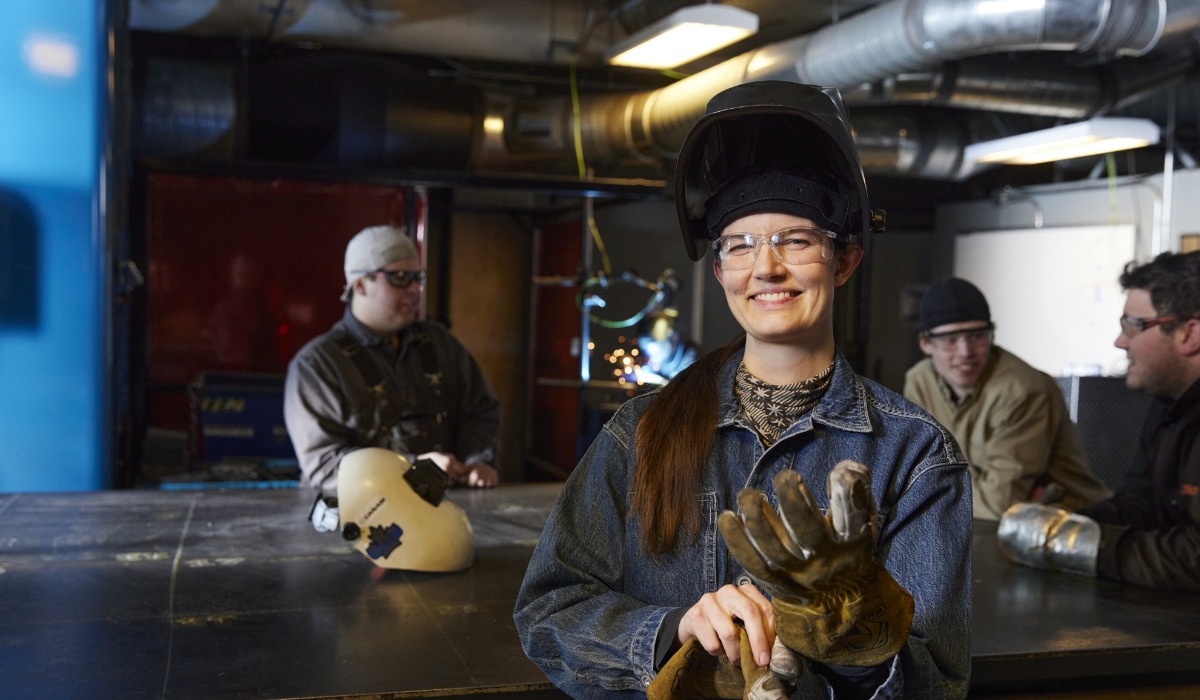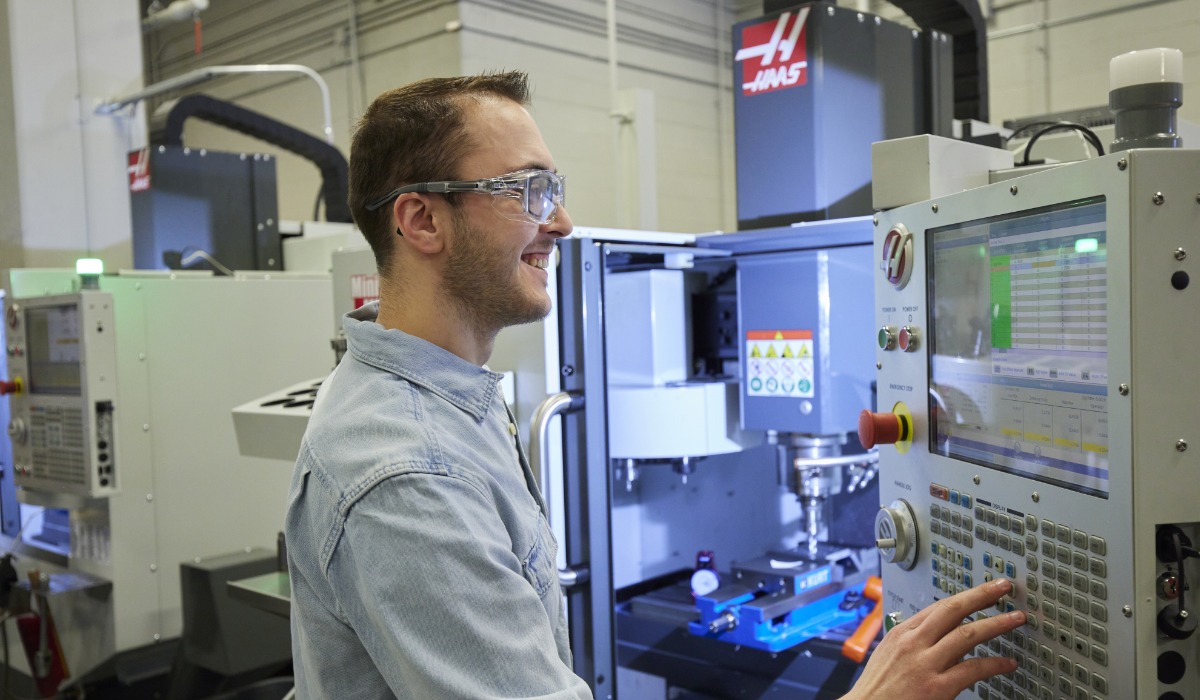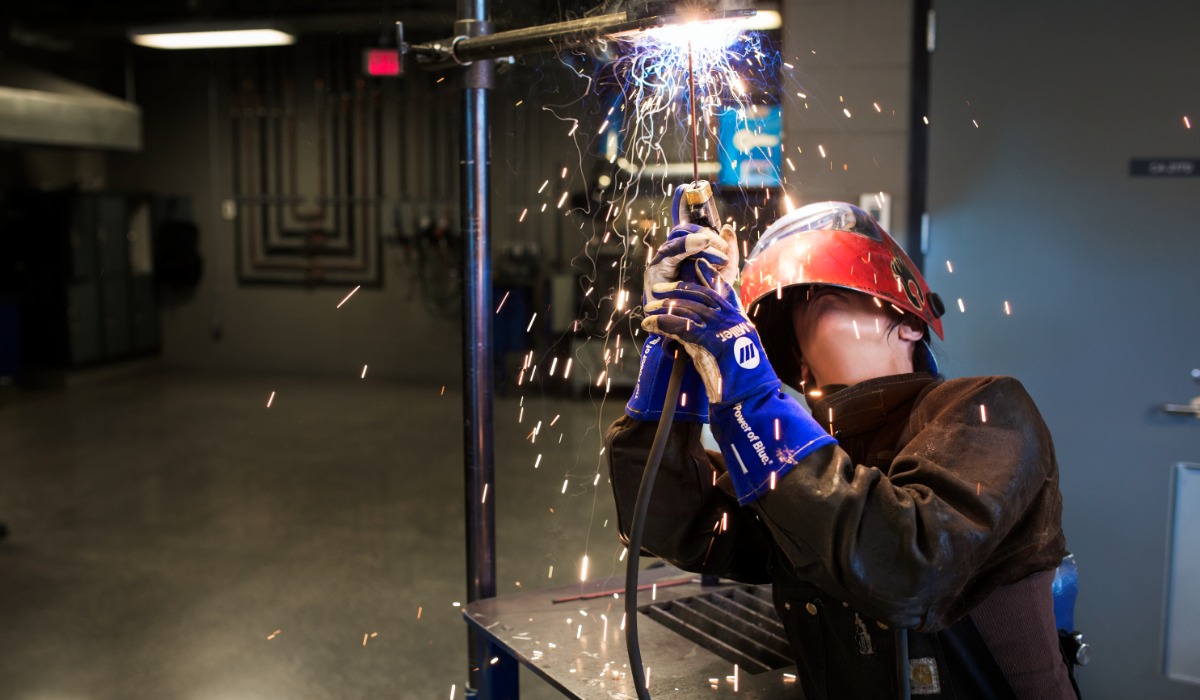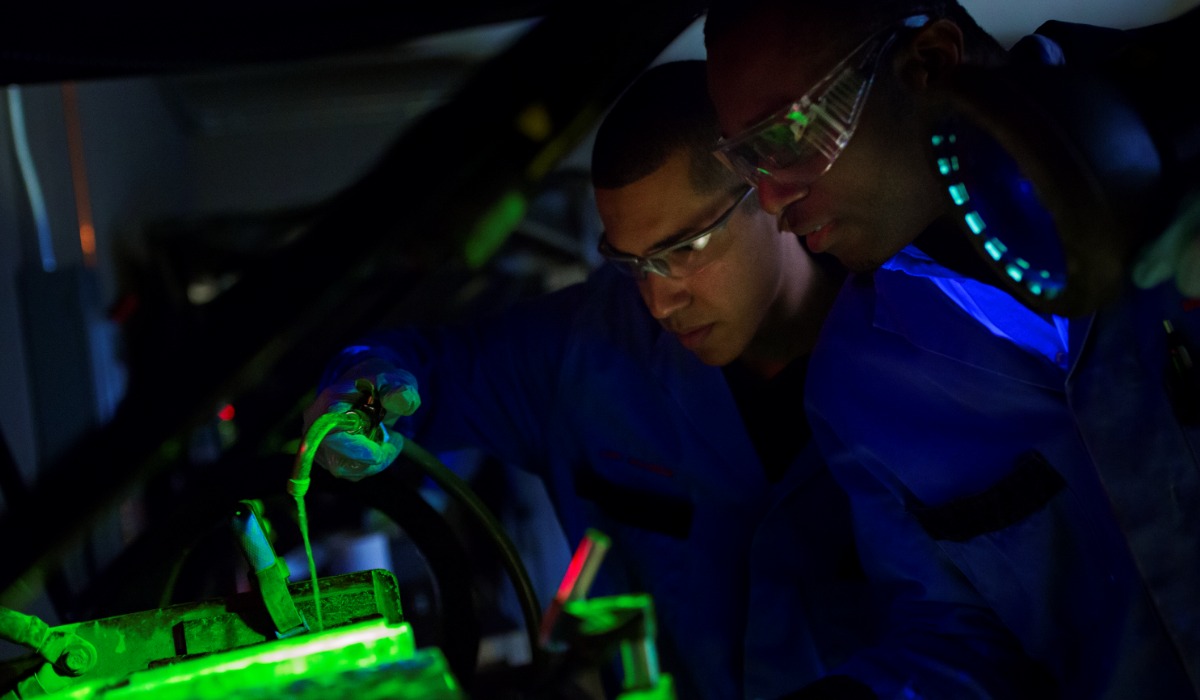Overview
Learn how to weld and become a well-informed tradesperson with a comprehensive understanding of the industry's processes and tools.
The Welding and Fabrication Technology program provides an integrated learning experience, combining theoretical knowledge with practical, hands-on skills in a blend of classroom and lab work. The program aligns with the Alberta Apprenticeship and Industry Training (AIT) curriculum for the welding trade.
You will learn from faculty with real-world experience who will provide industry insights and mentorship. You'll have access to modern welding facilities and equipment and networking opportunities with industry professionals and potential employers.
As a student, you will:
- learn industry-standard welding processes and tools, including for aluminum, steel or other metals
- learn how to interpret complex drawings, adhere to strict standards and specifications, and keep current with welding codes
- learn welding and metal fabrication procedures using the latest and emerging technologies in the field
- gain business and entrepreneurship skills for effective decision-making, job planning, tool and material selection, and operational sequencing
- gain mathematical and communication abilities for interacting with various stakeholders and accurately estimating project materials and resources.
Become a journeyperson welder
This program offers an alternate route to traditional apprenticeship, providing the foundational knowledge necessary for the trade. It prepares you to be apprenticeship-ready, needing only to register with an employer to begin accumulating on-the-job hours towards a journeyperson welder certification and pass the applicable exams.
If you seek a comprehensive welding and fabrication education or want to enhance your employability in the industry or manufacturing sector, the Welding and Fabrication Technology program can help you get there.
Those in the welding field tend to be objective, methodical and innovative.
You need:
- manual dexterity
- good vision (corrective lenses are acceptable)
- good hand-eye coordination
- attention to detail
- patience.
You should enjoy building things and working with little direction or supervision.
This program aligns with the Alberta Apprenticeship and Industry Training (AIT) curriculum for welders.
Graduates are eligible to challenge the technical training exams for periods one through three. Upon passing, you can register as an apprentice and complete the on-the-job training hours to earn your journeyperson designation.
The optional cooperative work term between years one and two allows you to apply your classroom learning in the workplace, gain valuable industry experience and complete some of the hours required to earn your journeyperson designation.
Upon successful completion of this program, you'll receive a SAIT Welding and Fabrication Technology diploma.
Careers and opportunities
Our graduates may work in the following occupations. Some careers require additional experience and education.
Associated National Occupational Classification (NOC) codes: 72010, 72103, 72104, 72105, 72106, 92023.
Career planning support
Unsure which career path is for you? Here are some recommended career planning resources to help you decide your future.
You can also head to Alberta alis for lots of information about careers in Alberta, including quizzes and labour market information to help you narrow down a path.
Finally, you can take our online career finder quiz, which can help narrow your options based on your current skills and interests.
Courses
The Welding and Fabrication diploma requires 60 credits (21 courses) to complete.
The program spans two years, with two to three semesters in the first year (depending on if you choose to complete the optional work term), and two semesters in the second year.
| Course | Credits |
|---|---|
|
This course introduces you to the fundamentals of reading blueprints. You'll learn to interpret structural drawing, pressure vessel drawings and piping drawings. Pre-requisites:
|
3 |
|
Learners will gain an understanding of the strategies and skills required for effective communication in a professional environment. Topics include active listening, conflict resolution, writing industry specific reports and documents, developing interview skills, and giving and receiving feedback. |
1.5 |
|
This course introduces you to non-destructive and destructive testing methods. You will also learn about metallurgical properties of steel, welding codes, standards and specifications. |
1.5 |
|
In this course, you will be introduced to the key principles and practices of effective personal finance, while exploring how to articulate your personal financial goals in terms of end results and action steps. You will use digital platforms to obtain relevant financial information, and you will examine the personal traits and required procedures for entrepreneurship. The course includes an exploration of the uses and features of key financial statements, and you will have hands-on practice developing a business plan. |
3 |
|
This course introduces you to the fundamental mathematical principles that you will need to meet the requirements for a welder. You'll explore the trade applications of fractions and decimals, as well as metric and imperial conversion and geometric problems. You'll learn to solve problems using percentage and ratios. You'll also learn to do trigonometry calculations and offsets for piping systems. |
3 |
|
This course provides students with the opportunity to develop practical welding skills while adhering to shop safety procedures. Students will develop practical skills in oxyfuel cutting and perform gas metal arc welding (GMAW) and flux-cored arc welding (FCAW) in multiple positions on mild steel. They will gain hands-on experience with welding processes for various joint configurations and structural shapes. Through practice, students will use inspection tools to measure weld coupons. |
3 |
|
This course introduces students to the fundamental theory required to work safely and effectively as a welder. Students begin by examining important procedures for working with hazardous materials, as well as safety regulations and standard practices for climbing, lifting, rigging, and hoisting. Students will explore hand tools and power tools, electrical concepts related to welding, how to perform equipment setup, maintenance, troubleshooting, and oxyfuel cutting with specialized equipment, as well as the theory of GMAW, FCAW, and MCAW welds on mild steel. |
3 |
|
This course equips students with the foundation for analyzing basic joints and weld types and identifying weld faults and distortion. Through practice, students will demonstrate safe material handling procedures. Students will establish an overview understanding of metallurgy, hardfacing process and heat treatment process. Through activities, students will develop skills to identify welds and welding symbols and interpret drawings. Additionally, this course will introduce students to oxyfuel, plasma arc and carbon arc cutting and gouging, submerged arc welding processes as well as GMAW, FCAW and MCAW on Mild Steel Pipe. Finally, students will distinguish the characteristics of aluminum and how it affects the welding process. |
3 |
|
In this lab, you will learn how to perform fillet and groove welds in all positions on mild steel plate and pipe using the shielded metal arc welding (SMAW) process. |
3 |
|
This course provides opportunities to practice intermediate welding skills. Students will perform gas metal arc welding (GMAW), flux-cored arc welding (FCAW) and metal-cored arc welding (MCAW) in multiple positions on mild steel., as well as cutting and gouging using the plasma arc and carbon arc processes. Students also perform gas metal arc welding (GMAW), flux-cored arc welding (FCAW) and metal-cored arc welding (MCAW) on aluminum and mild steel. In addition, students observe and explain the submerged arc welding (SAW) process. |
3 |
|
This course introduces you to the fundamentals of gas tungsten arc welding (GTAW), beginning with safe work practices and procedures. You will examine the correct use of GTAW electrodes, filler metals and gases, as well as explore troubleshooting and maintenance procedures for GTAW equipment. You'll also examine the GTAW procedures and parameters for welding mild steel plate and pipe, stainless steel and aluminum. |
1.5 |
|
In this lab, you will learn how to perform fillet and groove welds in all positions on mild steel, stainless steel and aluminum plate using the gas tungsten arc welding (GTAW) process. |
3 |
|
This course introduces you to the fundamentals of shielded metal arc welding (SMAW) equipment and techniques, beginning with the characteristics and applications of SMAW electrodes. You'll explore the classification and production process of cast iron and steel, as well as the characteristics, weldability and applications of carbon steels, alloy steels and alloy steel filler metals. You will also examine the SMAW process on mild steel and the weld procedures and parameters for SMAW fillet welds and groove welds. The course concludes with an examination of Canadian Welding Bureau (CWB) test procedures. |
3 |
|
This is a course on pattern development and estimating. Learners develop and apply pattern development, layout, and project estimating skills. Pre-requisites:
|
3 |
|
In this certification lab, you will develop the hands-on skills required to perform fillet and groove welds on mild steel plate. While following the qualification standards established by the Canadian Welding Bureau (CWB), you will apply the flux cored arc welding (FCAW) and shielded metal arc welding (SMAW) processes, evaluate guided bend test procedures, prepare CWB test coupons for evaluation, and perform CWB fit-up, tacking and welding procedures. The skills and knowledge you gain from these lab activities will prepare you to take the CWB practical tests in the 1GF and 2GF weld positions. Pre-requisites:
|
1.5 |
|
In this course, you will develop the practical skills required to weld in GTAW/SMAW in different positions on mild steel plate and pipe. Learning these skills will involve performing SMAW and oxyfuel cutting procedures; performing GTAW in the 1G, 2G, 3G, 5G and 6G positions; and performing SMAW in the 2G-5G, 5G downhill and 6G positions. Pre-requisites:
|
6 |
|
In this course, you will learn advanced welding theory related to Shielded Metal Arc Welding (SMAW) and oxyfuel cutting procedures on mild steel, SMAW in the 2G-5G and 6G positions on pipe, and Gas Tungsten Arc Welding (GTAW) on mild steel plate and pipe. These topics will cover cutting and welding procedures for nickel alloy and clad steels, as well as fit up, preparation and grinding procedures for both SMAW and GTAW. Pre-requisites:
|
3 |
|
This course is designed to help you develop your hand skills in performing fillet/groove welds on mild steel plate using the FCAW & SMAW process and to prepare you to challenge the CWB practical tests in these weld positions (1GF,2GF,3GF,4GF,) Pre-requisites:
|
3 |
|
Throughout this industrial fabrication techniques course, you'll delve into strategies for cost reduction in welding. Discover how to optimize labor, materials, consumables, and techniques. Gain insights into evaluating cost control elements relevant to weldment design and fabrication. Topics include deposition efficiency, deposition rate, operational factors, process choices, overweld control, and electrode selection. Additionally, you will learn practical applications of fabrication and best practices in the structural, pressure vessel and pressure piping construction techniques. |
6 |
|
In this course, you will explore basic mechanized and automated welding and cutting processes and how the technology is used in Industry. (Students will be given an opportunity to connect with industry and tour their facility to see how it works.) |
1.5 |
|
The Workplace Readiness course is designed to equip you with the soft skills and industry certifications that are essential for success in a dynamic work environment. Through hands-on exercises, you will develop key workplace competencies, cultivate resilience, master communication models, hone problem-solving skills, embody professionalism, and foster effective teamwork. This course integrates industry safety certifications so you enter the workplace industry-ready, equipped with safety knowledge and practice. |
1.5 |
| Course | Credits |
|---|---|
|
The cooperative work term course offers students an optional opportunity to augment their classroom learning by applying theoretical knowledge and gaining practical experience in a professional workplace setting. This course serves as a bridge between academic studies and real-world industry practices, enabling students to develop valuable skills, enhance their employability, and establish connections within industry. |
0 |
Progression
You must attain a PGPA and/or a CGPA of 2.0 or better each semester and pass the prerequisite courses to progress through the program.
To qualify for graduation, you must pass all courses, attain a CGPA of 2.0 or better and complete course requirements within the prescribed timelines.
Admission requirements
Applicants educated in Canada
Applicants must demonstrate English language proficiency and meet the following requirements or equivalents:
- at least 50% in English Arts 20-1 or English Arts 20-2, and
- at least 50% Math 20-1, Math 20-2 or Math 20-3, and
- at least 50% Science 10.
Those who have graduated from SAIT's Welding Technician certificate program within the last five years may be given advanced standing into year two or the program, depending on seat availability.
SAIT accepts high school course equivalents for admission for applicants educated outside Alberta.
All applicants who were educated outside of Canada must demonstrate English language proficiency and provide proof they meet the program admission requirements outlined above with an international document assessment. Find accepted educational documents and assessment options.
SAIT may also accept courses completed at certain international post-secondary institutions.
Academic Upgrading
Missing an admission requirement for this program? Upgrade your prior education to help you receive admission into one of SAIT's career programs.
English language proficiency
All applicants must demonstrate English language proficiency prior to admission, including students educated in Canada.
Transfer agreements
At SAIT, we have created transfer agreements with partner institutions to allow you to earn course credits toward your SAIT program based on your previously completed credentials.
Transfer Alberta search tool
Use the Transfer Alberta search tool to see all transfer agreements between Alberta post-secondary institutions (including those with the University of Calgary, Mount Royal University and Bow Valley College.)
Search transfer agreements in Alberta
Transfer options for graduates
When you have completed this program, you may continue your education at a partner post-secondary institution. These transfer agreements include partnerships within and/or outside of Canada.
Available intakes
Winter 2026
Start dates:
- Domestic students: Closed
-
-
Application deadline:
-
- International students: Closed
-
-
Application deadline:
-
Fall 2026
Start dates:
- Domestic students: Open
-
-
Application deadline: June 30, 2026
-
- International students: Open
-
-
Application deadline: May 29, 2026
-
Winter 2027
Start dates:
- Domestic Students (apps open March 1, 2026): Closed
-
-
Application deadline: Oct. 23, 2026
-
- International students: Open
-
-
Application deadline: Oct. 9, 2026
-
Costs
2025/26 tuition and fees
The following estimated costs are effective as of July 1, 2025.
The estimated total cost of tuition and fees is based on the suggested schedule of study. Following a modified schedule will impact the fees you pay per semester and may alter final costs.
Domestic students
The program total is based on the estimated amount you will pay if you enter this program during the 2025/26 academic year. The program total amount listed on your letter of admission may appear higher. This amount is your maximum tuition guarantee for the program. SAIT will not exceed this maximum, regardless of changes in tuition and fees between academic years.
Books and supplies are approximately $2,000 per full-time year.
This is a bring-your-own-device program with a standard computer hardware and software requirement. See the specific requirements on our computers and laptops page.
Find your booklist on the SAIT Bookstore's website. The booklist will be available closer to the program start date. Can't find your program or course? The bookstore didn't receive a textbook list. Contact your program directly to determine if they're still refining course details or if you're in luck; no textbook purchase is required this term.
Financial aid
Paying for your education may feel overwhelming, but we have resources and programs that can help, including information about payment options, student loans, grants and scholarships.
Application process
Ready to apply?
Follow our step-by-step guide to submitting a successful application.
Communication during admission
Email is the primary source of communication during the selection process. Ensure your personal email account is managed appropriately to receive our emails, files and communications. We recommend you add the transportation.info@sait.ca domain to your safe senders list or you risk missing critical email messages.
Begin your application
Apply now using the online application portal.
Ensure you have a valid Visa or Mastercard to pay the non-refundable application fee of $120 for domestic applicants or $175 for international applicants.
Information sessions
Prepare for a strong start in your chosen program or get the details you need to decide your future path.
Our expert staff and faculty are ready to answer your questions and provide information about the following:
- What sets SAIT apart
- An introduction to the program and area of study
- Admission requirements
- Future career paths
- Information on the earning potential and graduate employment rates.
Contact us
School of Manufacturing and Automation Advising
-
Phone - 403.284.8641
-
Email - ma.info@sait.ca
International Student Advising
-
Phone - 403.284.8852
-
Email - international@sait.ca
Subscribe for updates
Your journey starts here! Sign up to get important updates on:
- Manufacturing and automation programs
- Application information
- Relevant news and events

Oki, Âba wathtech, Danit'ada, Tawnshi, Hello.
SAIT is located on the traditional territories of the Niitsitapi (Blackfoot) and the people of Treaty 7 which includes the Siksika, the Piikani, the Kainai, the Tsuut’ina and the Îyârhe Nakoda of Bearspaw, Chiniki and Goodstoney.
We are situated in an area the Blackfoot tribes traditionally called Moh’kinsstis, where the Bow River meets the Elbow River. We now call it the city of Calgary, which is also home to the Métis Nation of Alberta.




